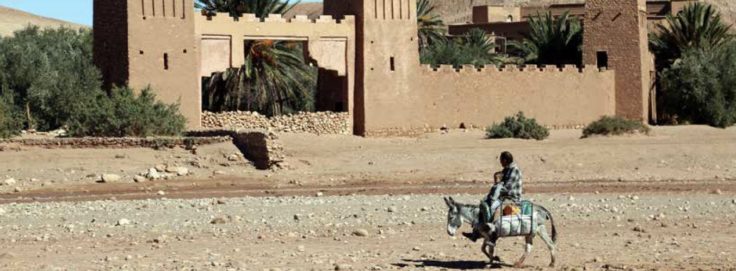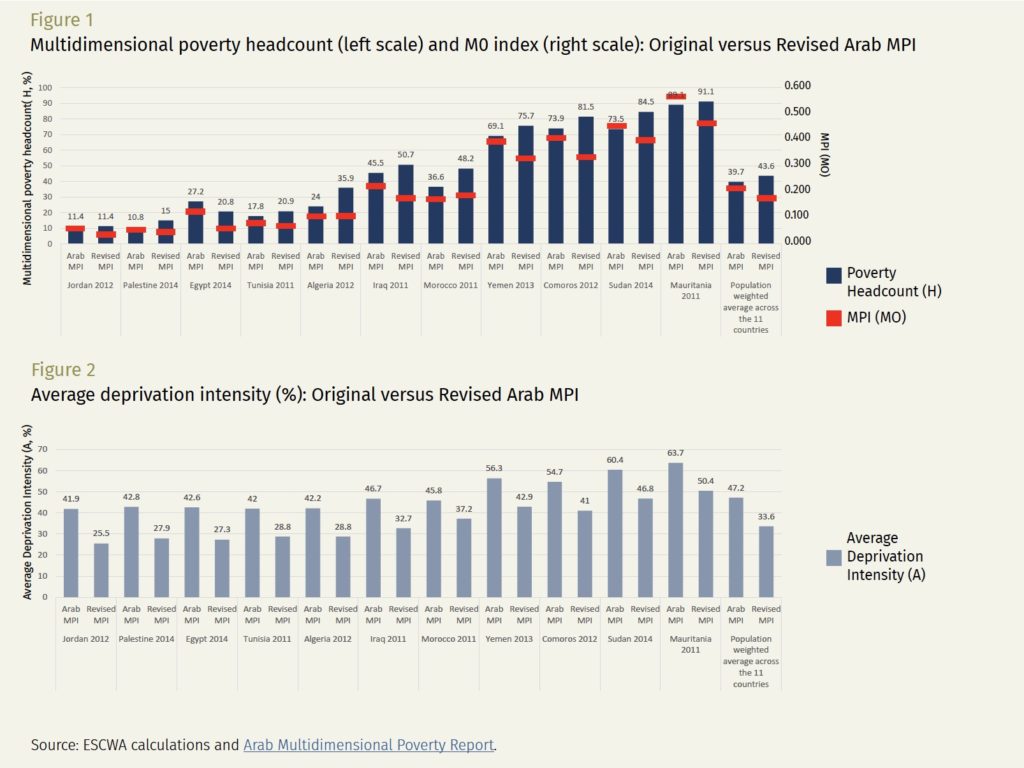
Search
The Revised Arab MPI: Multidimensional Poverty Index for Arab countries

In December 2020, the League of Arab States Social Ministerial Council endorsed the ESCWA-proposed Revised Arab MPI framework as a formal tool for monitoring and tracking multidimensional poverty, and the basis for the second interagency report on multidimensional poverty in Arab countries. This article briefly reviews the process that led to its formal adoption, the structure of the index, and the profile of poverty in Arab countries according to this index.
Path toward formal adoption
In 2017, the United Nations Economic and Social Commission for Western Asia (ESCWA) partnered with the League of Arab States (LAS), Oxford Poverty and Human Development Initiative (OPHI) and the United Nations Children’s Fund (UNICEF) to launch the first Arab Multidimensional Poverty Report. The report embraced the Alkire-Foster method and Sen’s capability approach and proposed an Arab Multidimensional Poverty Index (MPI) that assessed nonmonetary deprivations across three dimensions: education, health, and living standards.
The index was tailored to the Arab region’s realities, and introduced poverty definitions that corresponded with moderate degrees of deprivation in middle income and medium-ranked human development countries.
The Arab MPI has no doubt made an important contribution to poverty measurement and policy debates in the region. However, the index remained in its construction close to the global MPI by retaining the same dimensions and most of the same indicators.
The major shifts witnessed in the region since the adoption of the Arab MPI in 2017, and the need for more dynamic measurement of poverty have also led ESCWA and its partners to work on revising the index. The resulting Revised Arab MPI is a product of an extensive analytical and consultative process among numerous stakeholders and experts. Decisions taken during the construction of the index were based as much on technical grounds as on normative ones.
As Anthony Atkinson noted, ‘The measurement of poverty is not a purely technical subject… the right answers depend on views that are politically influenced and, at heart, matters of moral judgement. They are influenced by culture and history’ (p.212).
The consultations spanned two years, culminating in a meeting with regional and global experts in Amman on 18–19 December 2019 where the basic qualities of the revised framework were agreed. Over the following months ESCWA’s analytical team worked on implementing all empirical refinements, incorporating comments, and conducting consistency and robustness tests on the finalized framework. In September 2020, the Revised Arab MPI was sent for a formal review by all Arab states, and their responses were filed. The index made it on the agenda of the LAS Ministerial Meeting where it was debated. At last, in December 2020, the Revised Arab MPI was formally adopted by the LAS Social Ministerial Council as a tool for monitoring and tracking multidimensional poverty in the region.
Revised Arab MPI structure
The revised regional MPI builds on the original Arab MPI framework, while being guided by recent developments in multidimensional poverty research.
The choice of dimensions and indicators, and their respective thresholds for deprivation, is made in consideration of their relevance to the region, the principles of human rights and the Sustainable Development Goals (SDGs), as well as cross-country data availability. The choice is also the product of the inter-agency participatory process. Particular attention has been paid to improving the Arab MPI’s intercountry comparisons, retaining temporal comparability, and better capturing the manifestations of poverty prevailing in Arab middle-income countries.
The main innovation in the revised Arab MPI is its assessment of poverty in both material and social capability spaces, and the allocation of equal weights to both of these pillars. This approach provides a more comprehensive and balanced representation of poverty, particularly as Arab countries have witnessed progress in social wellbeing but less so in material and living-conditions wellbeing. Within the pillars, the capability (or non-material) aspect of poverty is reflected in the health and education dimensions.
Material (or living standards) poverty is reflected in the housing, access to services, and assets dimensions. These dimensions are equally weighted within their pillars, as are the individual indicators within thedimensions. The revised Arab MPI thus relies on two pillars, five dimensions, and 14 indicators. The classification of multidimensional poverty is set at a deprivation score of 20%, that is, households deprived in at least one dimension, or more than one-fifth of all indicators will be considered multidimensionally poor.
The dimension of health includes three indicators: child mortality, child nutrition and child pregnancy. Compared to the original Arab MPI, most notably, adult malnutrition and female genital mutilation are omitted due to coverage issues across countries. The child nutrition indicator is also refined by considering underweight instead of wasting to mitigate seasonality biases.
The main innovation in the revised Arab MPI is its assessment of poverty in both material and social capability spaces, and the allocation of equal weights to both of these pillars.
The dimension of education includes three indicators: school attendance, age schooling gap (schooling repetition) and adults’ educational attainment. Compared to the original Arab MPI, most notably, school attendance and age schooling gap were separated into two indicators as they reflect different concepts that need to be addressed differently.
The dimension of housing includes two indicators of housing adequacy: overcrowding, and type of dwelling. Compared to the original Arab MPI, overcrowding is now evaluated among 10+ year olds, accounting for the importance of children’s privacy.
Deprivation in the type of dwelling is broadened to better capture regional housing conditions: it newly flags places other than stand-alone houses or apartments, as well as homes with a non-permanent floor or roof.
The dimension of access to services includes improved drinking water and sanitation, and access to electricity.
Finally, the dimension of assets covers three separate asset groups: communication, mobility and livelihood assets. Compared to the original Arab MPI, these asset groups are selected not only based on their individual functions, but also their material values and data availability. These assets may serve as indicators for enhanced individual capacities to deliver particular functions (such as mobility and communication), and thus enhanced achievement of particular capabilities. The refined definition improves cross-country comparability and mitigates biases.
The revised index is deemed to better capture the multiple facets of poverty unique to the region, is better at addressing data limitations, facilitates better inter-country comparisons and retains temporal comparisons. The revised index reflects the long-standing policy focus of Arab governments on combating moderate degrees of deprivation, particularly as substantial progress on reducing extreme poverty had been made in the early 2000s.
The focus on moderate poverty is also consistent with the way national poverty lines are set, ensuring policy-relevance and compatibility of the measures of multidimensional and money-metric poverty. Finally, the revised index shows desirable properties with respect to the joint validity of the set of indicators (indicator redundancy tests) and country-ranking stability with respect to the choice of weights and poverty cutoff (robustness tests).
Results
The revised Arab MPI poverty headcounts range from 11.4% in Jordan to 91.1% in Mauritania. Most Arab countries exhibit increases in poverty incidence using the revised index, with the rate of increase relative to the original Arab MPI being highest in middle-income countries as the revised index was tailored to better capture poverty there. The higher poverty headcounts coupled with lower average deprivation intensities in the revised framework are due to the revised structure including the lower poverty identification cut-off, capturing moderate forms of poverty.
The average intensity of deprivation among the poor is near 30% in most countries, and near 50% in two Arab least developed countries (LDCs), Mauritania and the Sudan. Across the 11 regional countries, 43.6% of residents are multidimensionally poor. The average intensity of deprivation is 33.6%, yielding an MPI score of 0.164.
In terms of poverty composition, deprivation in education remains the lead contributor to multidimensional poverty, but the combined contributions of indicators for housing, services and assets exceed the contributions of health and education in many countries, suggesting that the region’s gains in material well-being may be lagging behind those in human capital.
Conclusions and implications
This article has aimed to describe the developments in the conceptualization of multidimensional poverty measurement in the Arab region since the launch of the 2017 Arab Multidimensional Poverty Report, and the path toward the adoption of the revised Arab MPI by the LAS Social Ministerial Council.
We have described the dimensions, indicators, and weights of the revised Arab MPI, noting the major departures from the original Arab MPI, and the desirable properties of the revised index. Using the same household surveys included in the first Arab Multidimensional Poverty Report, we have shown that the revised index yields higher poverty headcounts coupled with lower average deprivation intensities, and thus very similar adjusted poverty headcounts to those under the original index.
The revised Arab MPI will serve as the basis for the Second Arab Multidimensional Poverty Report. However, in view of the setbacks encountered due to COVID-19 and the potential delays to data collection, consultation and analysis, the work leading up to the report will be extended to track carefully the evolution of multidimensional poverty in countries for which multiple health surveys become available, and the report will be scheduled to the year 2023 by which time an expanded set of surveys for regional LDCs will have been published.
This article was published in Dimensions 12

















